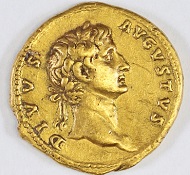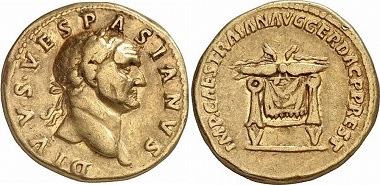May 26, 2016 – The famous British Museum possesses an aureus of Trajan that until now was unique. The coin bears the portrait of Augustus and was minted by Trajan in 107. This coin forms part of a series of dedicated to the exemplary Roman emperors that ruled before Trajan.
Laurie Rimon, member of Kibbutz Kefar Blum, found this spectacular coin when hiking with friends in the countryside. Photograph: Israel Antiquities Authority.
Now a second specimen was discovered by Laurie Rimon, a member of Kibbutz Kefar Blum, who was hiking with friends in the countryside.
During a recent trip to the eastern Galilee a group of veteran hikers, including Laurie, arrived at an archaeological site. Suddenly Laurie discerned a shiny object in the grass. When she picked it up she realized it was an ancient gold coin. The group’s guide, Irit Zuk-Kovacsi contacted the Israel Antiquities Authority (IAA) with the help of archaeologist and veteran tour guide Dr Motti Aviam, and within two hours an IAA representative joined the group of hikers in the field. Laurie turned the rare find over to him admitting, “It was not easy parting with the coin. After all, it is not every day one discovers such an amazing object, but I hope I will see it displayed in a museum in the near future”.
Nir Distelfeld, an inspector with the IAA Unit for the Prevention of Antiquities Robbery, noted, “Laurie demonstrated exemplary civic behavior by handing this important coin over to the Antiquities Authority. … This is an extraordinarily remarkable and surprising discovery. I believe that soon, thanks to Laurie, the public will be able to enjoy this rare find. It is important to know that when you find an archaeological artifact it is advisable to call IAA representatives to the location spot in the field. That way we can also gather the relevant archaeological and contextual information from the site”. In the near future the Israel Antiquities Authority will award Laurie a certificate of appreciation for her good citizenship.
The coin was minted in 107 CE by Emperor Trajan and commemorates the first Roman Emperor Augustus. Photograph: Israel Antiquities Authority.
According to Dr. Danny Syon, a senior numismatist at the Israel Antiquities Authority, “This coin, minted in Rome in 107 CE, is rare on a global level. On the reverse we have the symbols of the Roman legions next to the name of the ruler Trajan, and on the obverse – instead of an image of the emperor Trajan, as was usually the case, there is the portrait of the emperor ‘Augustus Deified’. This coin is part of a series of coins minted by Trajan as a tribute to the emperors that preceded him”.
Another coin from this series. While aurei featuring Augustus are extremely rare, coins showing portraits of Vespasian and Titus can be found on the market from times to times. From auction sale Gorny & Mosch 159 (2007), 397.
According to Dr. Donald T. Ariel, head curator of the coin department at the Israel Antiquities Authority, “The coin may reflect the presence of the Roman army in the region some 2,000 years ago – possibly in the context of activity against Bar Kokhba supporters in the Galilee – but it is very difficult to determine that on the basis of a single coin. Historical sources describing the period note that some Roman soldiers were paid a high salary of three gold coins, the equivalent of 75 silver coins, each payday. Because of their high monetary value soldiers were unable to purchase goods in the market with gold coins, as the merchants could not provide change for them”. Dr. Ariel added, “Whilst the bronze and silver coins of Emperor Trajan are common in the country, his gold coins are extremely rare. So far, only two other gold coins of this emperor have been registered in the State Treasures, one from Giv‘at Shaul near Jerusalem, and the other from the Qiryat Gat region and the details on both of them are different to those that appear on the rare coin that Laurie found”.
This is the website of the Israel Antiquities Authority.
Addendum
Numerous attentive readers pointed out that this aureus is not the second known specimen of this type as claimed by the official press release by the Israel Antiquities Authority published above, but it is in fact the sixth specimen known as listed in the reference work by Bernhard Woytek. The other ones are located as follows:
- BMC 699, London
- CBN 476, Paris
- Münzkabinett der Staatlichen Museen Berlin, Berlin
- Museo Nazionale Romano, Rome (ex collezione Gnecchi).
- Museo Archeologico di Napoli, Naples (ex collezione Fiorelli 7835)
You can find more detailed information on this type in the Berlin Münzkabinett Online Catalogue where the coin type is also dated slightly later to 112-114 CE.








